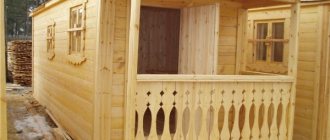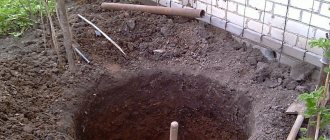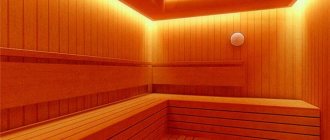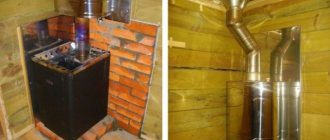What should you keep in mind before starting installation work?
Do you want to ensure that no unpleasant surprises await you during sewer construction work?
Consider the following nuances:
- to what depth the soil freezes in winter;
- how often the sauna will be used;
- whether there is a sewer line on the site or nearby;
- what is the composition of the soil on which the bathhouse stands in the country. Some types of sewage systems are best installed where the soil has a well-absorbing composition (sandy soils, pebbles, crushed stones, etc.).
Determining the location
Previously, bathhouses were built mainly without a toilet, since the toilet was located in the yard and everyone used it. There were no toilets in the houses either - they considered it something unnecessary. But modern man has become accustomed to comfort in everything and is no longer ready to put up with inconvenience even when visiting his own bathhouse. Therefore, installing a bathroom in a bathhouse is very relevant and in demand. The main nuance in this matter is the fact that the bathhouse, as a rule, is small in size, and it is not easy to allocate a space in it even measuring one meter by one meter.
In addition, the bathhouse is finished with natural wood and the building itself is also often built from wooden logs, so the owners fear that it will be difficult to organize ventilation. After all, wooden surfaces absorb odors very strongly, and the toilet can ruin any vacation. But not everything is so simple here. If you choose the right location for the toilet and comply with all the technology requirements, the result will be quite reliable and acceptable.
So, the toilet must be located so that the entrance to it is not visible from the rest room; it is better to organize such a “nook”. This will not only avoid drawing unnecessary attention to such a delicate issue, but also possible odors will linger. Also, when choosing a place for a toilet, you need to take into account the location of the sewer pipe or septic tank on your site, since you will have to drain the drain exactly there and the shorter the distance, the lower the costs.
It is also worth saying a few words in favor of completely abandoning the toilet in the bathhouse, because such an opinion is quite common and even occurs more often than a decision in favor of comfort. So, a toilet in a bathhouse will lead to the following inconveniences:
- The area of the building will have to be increased or the size of the internal premises reduced.
- You will have to install a separate cesspool or obtain permission to tap into the sewer.
- It will be necessary to supply water to the building and organize its safety in the winter, when the bathhouse is rarely used.
- Purchase of plumbing and finishing costs.
But if all these problems don’t scare you, then let’s move on to the immediate description of the work.
The toilet in the bathhouse should be located so that it does not attract unnecessary attention.
Types of sewer systems for baths
Regardless of whether the bathhouse is built on a strip foundation or on screw piles, there are three main ways to remove water from the bathhouse.
The sewerage scheme is developed individually in each case, but you can see typical ones in the photo below.
The most common types of sewerage
If you do not have access to a central sewer system, then:
- pressure;
- non-pressure (drainage).
If there is a central sewer near your house, you can join it.
Gravity sewerage
In a simple bathhouse at the dacha, as a rule, a regular drainage system is installed.
It looks like this: water flows through the pipes from the bathhouse towards the sump; for this, the pipes are laid slightly at an angle. The pump is not used.
The diagram of this type of sewage system is visible in the photo below.
The advantages of such a system:
- cheap materials;
- ease of installation even for a non-professional builder;
- the design is intuitive; it’s not difficult to think about how it should look on your site;
- durability of use.
Installation instructions for a gravity system:
- a well or drainage hole approximately 1.5 m deep is dug at a short distance from the bathhouse;
- A 10 cm layer of clay is placed at the bottom of the pit, and a layer of gravel, expanded clay or crushed stone is poured on top, i.e. any stone that provides drainage;
- the ground around the well and gutter (if the water will flow through the gutter and not through a pipe) is sealed with clay. This is done in order to avoid waterlogging of the ground in this place, the occurrence of constant puddles and an unpleasant odor;
- if the bathhouse will be used in winter, then you need to use a pipe for drainage, which must certainly be insulated so that it does not freeze at sub-zero temperatures.
The drainage well simultaneously performs all functions related to the removal and purification of water. Water is purified in the drainage layer and absorbed into the soil.
Therefore, it is important what the composition of the soil in which such a pit is built is.
If the soil at your dacha is clayey, then this type of water drainage will not suit you; it will drain poorly and stagnate.
It is also important, when designing this system, to take into account the terrain features of the dacha so that the water flows through the pipes on its own, otherwise they will often become clogged.
Caring for such a sewer consists of periodically (every 2-3 years) cleaning the drainage pit and diagnosing the condition of the pipes.
Pressure sewer system
It is installed where a gravity-fed one is not suitable. The technology for installing such a sewer system can be seen in the video below.
Video:
It includes a pump and a system of pipes to drain water into a settling tank, and then it is discharged to where it is purified.
Where is this technology used:
- where the terrain does not allow pipes to be laid so that water naturally flows into the drainage well, for example, when the bathhouse is located inside the house on the ground floor;
- where it is impossible to dig deep trenches for water drainage;
- where buildings are located too close to each other.
Advantages of this type of sewer system:
- relative ease of installation;
- reliability and durability with proper operation will last for years;
- low price of materials, the main expenses will go to the purchase of a pump.
This system is somewhat more complex than the drainage system, so periodic (2 times a year) diagnostics and, if necessary, cleaning are required.
Connection to central sewerage
Both of these options for removing water from the bathhouse can be associated with the third option - connecting to the central sewer system.
But this is only possible if it takes place in close proximity to the house. The greater the distance between the house and the Central Committee, the more expensive the entire system will cost.
The advantages of this method of installing a sewer system are that it functions uninterruptedly both in winter and in summer, and there is no need to clean the septic tank.
The main disadvantage is that it is not always possible to connect to the central sewer system; sometimes it is not possible to obtain permission from utility services.
For details on how to install such a system correctly, you can see the photo and video below.
Video:
Why do you need a sewer water seal?
When installing in a bathhouse connected to a general sewerage system, it is very important to properly organize the drainage of wastewater. The comfort and health of visitors will depend on this. After all, improper drainage can cause an unpleasant odor in the bathhouse and the spread of bacteria and pathogens.
Therefore, waste water in a bathhouse connected to a general sewer system is always discharged through special plumbing fixtures - water seals.
The special design of the water seals ensures unimpeded drainage of liquid, while preventing the spread of unpleasant odors in the steam room.
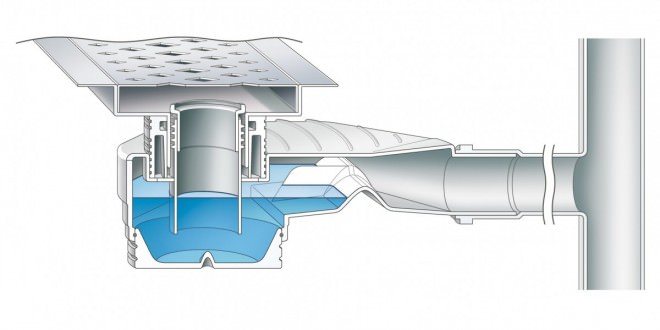
The design of the hydraulic seals ensures unimpeded drainage of liquid
In addition, the use of water seals allows:
- Avoid the penetration of sewage waste into the bathhouse pipeline;
- Minimize the percentage of blockages and contaminants in the sewer system.
If the bathhouse is equipped with a non-pressure wastewater disposal system, then, often, water seals are not used. After all, this principle of sewerage design involves installing pipes at an angle and draining water into a pit located outside the bathhouse. In this case, there should be no unpleasant odor.
We also recommend reading:
Thuja Brabant: 5 tips for planting and caring for hedges Features of installing a shower cabin with your own hands: 3 requirements Installing a stove in a bathhouse: 30 tips for placement and arrangement Winter insulation of the attic in 4 stages
Sewer insulation
In order for the bathhouse to function all year round, it is necessary to properly insulate the water supply and sewerage systems.
This will allow you to use the steam room even in the most severe frosts and will save you from unpleasant surprises.
To prevent the pipes under the bathhouse from freezing, they are laid at a depth greater than the freezing depth of the ground in winter. Piping should be routed only vertically.
It is recommended to use pipes made of low-density polyethylene with a diameter of 32 mm.
This material is good because even with repeated freezing it does not lose its properties; the pipes can simply be warmed up and used further.
To ensure that the vertical section of the pipe at a distance from the freezing depth to the entrance to the bathhouse subfloor does not freeze, it needs to be additionally insulated.
This can be done as follows: a heating cable is wound around the pipe, and the top is additionally covered with foamed polyethylene.
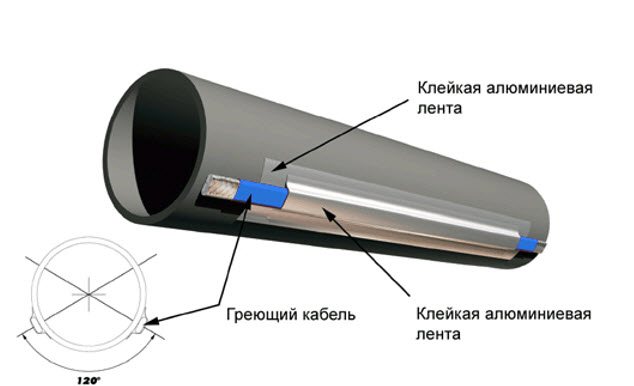
Features of winter toilets
To begin with, I’ll write a few words about what kind of toilets there are for use in cold rooms, i.e. which freeze:
- regular toilet (water closet or “WC”) - water from the cistern is used to flush and dispose of waste into the sewer network
- toilet bucket - no water used, no running water needed
- backlash-closet - the principle of a cesspool
- peat toilet - using peat backfill as an absorbent substrate
- vacuum toilet - a complex device like in airplanes
- composting toilet – minimal use of water and bacterial additives for disposal
To one degree or another, all these devices cannot simply be used in the winter in the toilets of a bathhouse, which freezes between trips to the steam room. The exception, perhaps, is a backlash closet in the form of an outdoor toilet, but when using it you have to forget about the most minimal comfort.
One of the most convenient options is to bring a dry toilet with you while using the bathhouse and take it away after bathing procedures, but it is not always convenient to carry a toilet with you in the car.
Read here about how to drain water in a bathhouse in winter
What to do to prevent the toilet in the bathhouse from turning into a headache in winter?
Let us omit the discussion of the option when people install a heated floor in the toilet for the sake of comfort; they do not consider the costs. But not everyone can afford this. The solution to the problem comes down to two components: the option of having a sewerage system and bases for it. If there is a sewerage system (even a local one), then the issue can be easily resolved by using some warm water. If there is no sewerage, everything is more complicated. This shitty question is raised on more than one ban forum.
- One way is to use a toilet without a flush tank. Such devices are widely used in railway passenger cars. The role of a water seal in them is played by a valve in the form of a flat plate, which blocks the sewer drain and is opened by a pedal. The disadvantages of such a toilet are the presence of a small amount of odors, although not as strong as when using a cesspool or a toilet bucket. Their pedal also freezes sometimes, but pouring a cup of boiling water solves the problem.
- Using an ordinary toilet and a cesspool or septic tank (or a large drain bucket of 30-40 liters buried in the ground) with the condition that after the end of the bath: the water from the tank is drained and the remaining water is scooped out of the water seal. This design requires warming up and initial filling of water into the tank before use. Some bathhouse lovers comfortably pour a little “car anti-freeze” into the water seal before leaving.
- If you use the dry water seal method (scoop the water out of the toilet before leaving), then you must insert a “plug” into the toilet to prevent odors from entering the pipes leading into the septic tank. How to remove water from a toilet? A large syringe that can be made from a 50 mm gray PVC sewer pipe.
Important! No amount of thermal insulation or insulation wraps will save the toilet from freezing if there is no heating device inside!
- Use of low-power self-heating electrical cables in the toilet seal to prevent it from freezing. The thing is not cheap, and has a drawback - it does not work when there is a power outage. A possible outcome of even a short-term power outage is the toilet freezing and bursting. And the procedure of constantly dipping the cable back and forth is not very aesthetic.
Source: dombrus.org.ua
Shower in the bath
Water can be supplied to the washing compartment of the bathhouse if this room is constantly heated. A heater needs to be installed in the shower room. Only cold water is supplied from the house, and it is heated in the bathhouse itself. Faucets for supplying cold and hot water, as well as shower heads are installed. The result is a modern shower room.
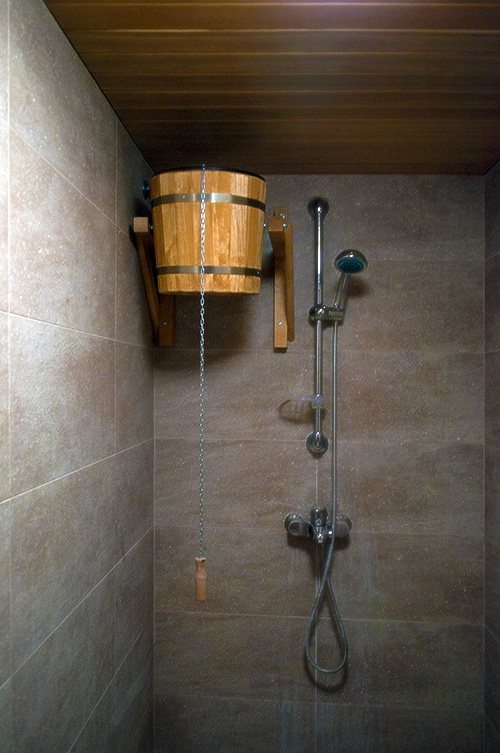
The water can be drained into a crushed stone filter. Since this wastewater contains a small amount of BAC, it is considered “gray”, so you can safely bypass the septic tank. A simple sump will do.
Of course, it is important that the shower room has good thermal insulation and is lined with moisture-resistant materials.


